| Visit a classic fossil site on California's Mojave Desert--the specific place that first inspired my life-long interest in paleontology. The locality now lies within the Mojave Trails National Monument (officially authorized and established on February 12, 2016), where the BLM (Bureau of Land Management) continues to allow the casual collection of reasonable amounts of common invertebrate fossils--a designation that here includes trilobites; for fossil sites situated on private property, visitors must secure explicit permission from the land owners. |

|
Click on the image for a larger picture. A Google Earth street car perspective--snapped in March, 2008--that I edited and processed through photoshop. The beckoning dirt trail (at just left of center) leads slightly east of due north to the southern end of the Marble Mountains (tallest peak in upper center), Mojave Desert, California, wherein lies one of the most famous fossil localities in all the world--the classic trilobite quarry in the lower Cambrian Latham Shale (roughly 515 million years old). It's a place I first visited as a child with my parents on a weekend camping excursion--the very experience that inspired my life-long fascinattion with paleontology. The Marble Mountains trilobite locality presently lies within Mojave Trails National Monument (officially authorized and established on February 12, 2016), where the BLM (Bureau of Land Management) continues to allow the casual collection of reasonable amounts of common invertebrate fossils--a designation that here includes trilobites; for fossil sites situated on private property, visitors must secure explicit permission from the land owners. |
|
|
|
|
|
|
|
|
|
|
|
|
|
And now for the preliminary obligatory words of caution. Endemic to the Mojave Desert of California, including the Las Vegas, Nevada, region by the way, is Valley Fever. This is a potentially serious illness called, scientifically, Coccidioidomycosis, or "coccy" for short; it's caused by the inhalation of an infectious airborne fungus whose spores lie dormant in the uncultivated, harsh alkaline soils of the Mojave Desert. When an unsuspecting and susceptible individual breaths the spores into his or her lungs, the fungus springs to life, as it prefers the moist, dark recesses of the human lungs (cats, dogs, rodents and even snakes, among other vertebrates, are also susceptible to "coccy") to multiply and be happy. Most cases of active Valley Fever resemble a minor touch of the flu, though the majority of those exposed show absolutely no symptoms of any kind of illness; it is important to note, of course, that in rather rare instances Valley Fever can progress to a severe and serious infection, causing high fever, chills, unending fatigue, rapid weight loss, inflammation of the joints, meningitis, pneumonia and even death. Every fossil prospector who chooses to visit the Mojave Desert must be fully aware of the risks involved. |
|
There are quite a number of popular rockhounding and fossil-bearing areas on the vast Mojave Desert, but one site in particular consistently attracts a great deal of attention. This is the classic Marble Mountains fossil quarry presently situated in Mojave Trails National Monument, San Bernardino County, California (officially authorized and established on February 12, 2016), where the BLM (Bureau of Land Management) continues to allow the casual collection of reasonable amounts of common invertebrate fossils--a designation that here includes trilobites; for fossil sites that occur on private property, visitors must first secure explicit permission from the land owners. Here in the Marble Mountains abundant and well-preserved fossil trilobites can be found dating from the early Cambrian geologic age, or roughly 518 million years old--some of Earth's most ancient identifiable animals with hard parts--those wonderful arthropod trilobites that as a group survived for nearly 300 million years before their eventual extinction just prior to the rise of the dinosaurs some 245 million years ago. The fossil trilobites in the Marble Mountains occur in a greenish to rusty-brown, platy-weathering shale called the Latham Shale, a detrital rock formation dated as lower Cambrian on the geologic time scale, or roughly 518 million years old. The Latham was named in 1954 by geologist John C. Hazzard for its excellent exposures on the western slopes of the Providence Mountains near an old and famous miner's cabin approximately 40 miles north of the Marble Mountains site--a specific place within the Providence range that is now off-limits to unauthorized collectors due to its inclusion in a federally protected wilderness area (one requires a special Bureau Of Land Management permit in order to collect legally within a federally administered wilderness region). Throughout its "type locality," in the region around the cabin where it was first described in the geologic literature, the formation is at least 60 feet thick and contains an abundant fauna of early Cambrian trilobites and brachiopods. At the classic trilobite quarry in the Marble Mountains, the Latham Shale averages around 50 feet in thickness and is also loaded with fossilized carapaces of trilobites, brachiopods, a siliceous sponge, a soft-bodied coelenterate (perhaps a jelly fish of some sort), an echinoderm and a mollusk or two. Virtually all of the trilobite specimens found at the old quarry--and in other exposures of the Latham outside wilderness boundaries, as well--were fragmental, although a few extraordinarily fortunate individuals reported that a whole, perfect fossil popped out at them from the shales. The main reason there are so few complete, intact trilobite specimens to be found in the Latham--and at other early Cambrian sites, for that matter--has to do with the original fragility of the animal's exoskeleton. In actual life, trilobites possessed a thin outer covering composed of chitin--a hard, horny substance protecting the delicate soft-bodied organism within. While this material can be preserved in the rocks for millions of years, the problem is that the primitive early Cambrian trilobites--among the earliest known animals with hard parts--had loosely attached body segments. Thus, the head, thorax (middle portion) and tail tended to separate very easily upon the animal's death. Also, trilobites molted throughout their lives, periodically shedding their chitinous external covering in much the same way their modern-day relatives, insects, crabs, scorpions and pill bugs regularly shed their own exoskeletons during the molting process. The result was that the trauma of the molting often caused the already free-moving body segments of the trilobite to disassociate and break off, to be scattered by the sea currents. All the trilobites found in the Latham Shale belong to a single significant family of trilobites called Olenellidae, or as they are more commonly called, olenellids. These were marvelously specialized arthropods, well adapted--for a time, anyway--to their life of burrowing in the muds of the shallow marine shelves along the margins of the early Cambrian land masses. Perhaps their most fascinating feature was their set of compound eyes, consisting of numerous minute calcite crystals in a closely packed arrangement. called scientifically a holochroal eye. It's not known for certain just how clearly the earliest trilobites were able to focus these eyes, but there is little question that, at the very least, they were able to distinguish adequately between predator and prey in their marine habitat. Mysteriously, though, the olenellids never survived beyond the early Cambrian, roughly 513 million years ago. Why they became extinct has never been fully explained, although the most logical idea is that, ultimately, they were ill-equipped to wage a successful struggle for life in their increasingly competitive environment. The Cambrian Period had ushered in the Paleozoic Era--the first occurrence of abundant complex animal life on Earth. It was a time of explosive biological diversification, and numerous burgeoning plants and animals were vying for every available ecological niche. Perhaps the olenellids, generally recognized by paleontologists as the earliest family of trilobites to appear in the geological record, could not overcome the inevitable encroachment of other increasingly aggressive varieties of trilobites into their domain. As a group, though, trilobites made it past the Cambrian Period and went on to flourish for close to another 300 million years or so, until at last they became extinct at the conclusion of the Permian Period, around 245 million years ago. Roughly 280 million years earlier, though, trilobites flourished, and their remains have been found on practically every continent on Earth. In the western United States--in California and Nevada, specifically--most well-known trilobite localities occur in early Cambrian through middle Ordovician-age rock deposits. And, of course, one of the most famous places in California to find early Cambrian trilobites was at the prime fossil quarry in the Marble Mountains. There, the oldest geologic rock formation exposed is the early Cambrian Zabriskie Quartzite. This is a massive, resistant accumulation of heat and pressure-altered sandstone, mostly unfossiliferous except for a stray olenellid or two, plus distinctive vertical tubes that paleontologists call Skolithos. These represent the feeding burrows and living chambers of some kind of ancient, extinct suspension feeder. Sitting directly atop the Zabriskie--in bold, dramatic stratigraphic contact--is the fabulous early Cambrian Latham Shale, the specific rock deposit which contained a profusion of trilobite remains at the fossil quarry in the Marble Mountains; it's approximately 50 feet thick here, consisting of rusty-red to greenish-colored shale that typically weathers to recessive slopes, often masked by eroding debris from the overlying, younger rock formations in the local stratigraphic section. All told, roughly 21 different species of fossils--from tracks and trails of soft-bodied organisms (who left no other evidence of their existence)--to a siliceous sponge have been identified from the Latham Shale of the Marble Mountains. In addition to trilobites, the fossil faunal list includes a coelenterate (possible jelly fish), three species of brachiopods, two kinds of mollusks, an annelid (worm), an echinoderm, anomalocaris fragments (this was the largest predator of the early Cambrian seas--olenellids likely ducked whenever they saw this monster lurking about...), and Girvanella nodules (precipitated by a species of cyanobacteria, blue-green algae). But by far the most-common specimens found are trilobites, whose remains in the shales typically consist of a lone head shield called a cephalon (although thoracic and tail segments are sometimes encountered, as well). While this fragmental preservation might appear meager and nondiagnostic, a single isolated cephalon is quite enough to accurately identify the genus-species of the animal from which it originated. The seven most-abundant species of trilobites found in the Latham Shales are (in no particular order of dominance in the fauna): (1) Bristolia bristolensis; (2) Bristolia insolens; (3) Olenellus nevadensis; (4) Olenellus mohavensis; (5) Olenellus fremonti; (6) Olenellus clarki; and (7) Olenellus gilberti. Additional trilobites identified from the Latham Shale include Bristolia anteros, Peachella iddingsi and two new species--one an olenellid, the other a ptychopariid. After the prolific trilobite remains, probably the second-most commonly found fossil specimen at the Latham Shale quarry was an unusual variety of brachiopod, referred to scientifically as Paterina prospectensis. This is one of the oldest species of brachiopods ever found, a significant find, indeed, but it was often overlooked by collectors in their single-minded eagerness to uncover trilobites. When spotted on the shales it closely resembles a tiny phonograph record, a flattened, circular to oval specimen slightly less than a half-inch in diameter. Lying directly above the trilobite-rich Latham Shale is a gray to dark blue ledge-forming limestone approximately 140 feet thick. This is the slightly younger lower Cambrian Chambless Limestone, within whose dense, rather massive strata occur prolific remains of a fossil algae. Many collectors at the trilobite quarry often developed quite a fascination and fondness for these extinct plant remains, taking time out from their intense trilobite-searching to look for the dark oval structures, roughly a half-inch to two inches in diameter, embedded in the lighter-colored grayish-blue limestones. For decades, paleontologists have called these curious algal bodies Girvanella, a catchall genus used to describe any nonspecified cyanobacterial remains present in rocks of Cambrian through Ordovician (475 million years ago) age in the Mojave Desert and neighboring Great Basin. Although very little is know about the possible life history of Girvanella, it is believed to have been a species of blue-green algae which, based on its exclusive occurrence in silt-free limestone, apparently preferred to propagate in warm, shallow, clear sea waters. In addition to Girvanella cyanobacteria bodies, the Chambless Limestone also yields two species of brachiopods, a mollusk, seven kinds of trilobites and an echinoderm. An aside here: Folks interested in finding probably the oldest photosynthesizing cyanobacterial algal remains on the Mojave Desert should investigate California's Alexander Hills District, southeast of Death Valley National Park, where Precambrian stromatolites over a billion years old occur; also present are early skeletonized eukaryotic cells of testate amoebae --around three-quarters of a billion years old--along with early Cambrian trilobites, archaeocyathids, annelid trails, arthropod tracks, and echinoderm material from the Wood Canyon Formation, which underlies the Zabriskie Quartzite. For all intents and purposes, the Chambless Limestone marks the uppermost, or youngest exposed horizon of the lower Cambrian system in the vicinity of the trilobite quarry. Above it occur shales, sandstones, quartzites and limestones of the predominately middle Cambrian Cadiz Formation, a sparsely fossiliferous unit approximately 75 feet thick. Some five species of trilobites have been recovered from it, in addition to three kinds of brachiopods. And above the Cadiz Formation, capping the entire sequence of Cambrian formations in the Marble Mountains, is the Upper Cambrian Bonanza King Dolomite, whose massive, thick accumulations of magnesium carbonate yield occasional, rare, "bonanza" layers of trilobites, plus locally abundant Girvanella algal bodies. It should be noted, of course, that the stratigraphic terminology used to describe Cambrian rock formations in the Mojave Desert and western Great Basin can be confusing. For example, throughout the northeastern Mojave Desert and southern Great Basin the three lower to middle Cambrian rock formations that outcrop in the Marble Mountains (Latham Shale, Chambless Limestone and Cadiz Formation) correlate stratigraphically with the lower (oldest) three members of the very widespread Carrara Formation; quite recently, by the way, one specific Carrara locality, many miles from the Marble Mountains, has generated a great deal of excitement among amateur fossil seekers, since it represents one of the few remaining places in all the Mojave and Great Basin deserts where unauthorized visitors can still legally collect early to middle Cambrian trilobites from the Carrara Formation. Then, too, in western Nevada and the neighboring northern Death Valley district of California, the stratigraphic nomenclature changes once again. Here, the fossiliferous Latham Shale correlates with the upper portion of the Harkless Formation, or the locally recognized Saline Valley Formation, where it is present in the famous Waucoba Spring section of Death Valley National Park. Above the Harkless/Saline Valley complex, lies the Mule Spring Limestone, whose massive bluish-gray accumulations of Girvanella-bearing calcium carbonates correlate quite nicely with the Chambless Limestone in the Marble Mountains. And the lower to Middle Cambrian Cadiz Formation is equivalent to the Monola Formation in northern Death Valley and the Emigrant Formation in adjacent western Nevada. All of these numerous Cambrian rock formations can be dated pretty accurately at some 518 to 515 million years old. At that distant time, the Marble Mountain trilobite quarry was situated near the equator in warm, shallow tropical sea waters that encouraged a genuine proliferation of early marine plants and animals. Today of course, thanks to the slow, sure inexorable power of Continental Drift--working its geologic magic through millions upon million of years--the trilobite-rich deposit occurs well north of the equator in present-day North America, where in the midst of a vast arid desert an uplifted, lithified bed of primal marine ooze holds the bodies of innumerable extinct arthropods, the trilobites, preserved for eons in a state of suspended animation, attaining a grand kind of immortality. At the Marble Mountains fossil quarry, trilobite hunters classically fall into their own individual styles of enthusiastic fossil-finding. One major collecting method is to sit upon the talus slopes and sift through the shale debris discarded by previous visitors. The idea here is to try to locate specimens that may have been left behind by hunters who in their rush to quarry the larger, more dramatic head shields, overlooked the less-obvious, though often better-preserved trilobites. A second and arguably more efficient technique is to clear a small, localized area of the overlying loose shale and then, with a quality chisel, in combination with a geology rock hammer or sledge hammer (be sure to sear safety glasses at all times), work your way through the shales, layer by layer, splitting the rocks along their natural bedding planes. This obviously involves a lot of work, but it is definitely the most productive way to find fossils. Wrap the pieces of fossiliferous shale in heavy-duty paper towels or even newspaper, to ensure their safe transport back home. Very little cleaning of the specimens is usually required, perhaps just a careful scrubbing with water and an old toothbrush to remove any dirt or grime caking the surfaces of the shales. Occasionally you may want to try to expose an inviting-looking, partially exposed head shield obscured by a layer of matrix on a large slab of fossiliferous shale. Proceed with caution, though, since the fossilized chiton carapaces are deceptively fragile; they tend to crack or crumble if subjected to an improper chiseling technique. Before attempting to work out a potentially exceptional find, practice on less well-preserved specimens or those you wouldn't mind losing should you make an accidental and fatal slip of the hand. There are of course loads of trilobites still remaining to be found in the Latham Shale, even after many decades of intensive collecting by both amateur paleontology enthusiasts and professional invertebrate paleontologists. The history of fossil explorations in the Marble Mountains begins in the early 1900s when geologist N. H. Darton discovered the southwesternmost exposure of fossiliferous Cambrian rocks in the United States. Darton was thus the first to collect trilobites in the Marble Mountains, but it's not clear whether his finds came from the exact area of the present-day trilobite quarry. For identification and age-assignment of the specimens, Darton submitted his collection to perhaps the most famous and knowledgeable Cambrian Period expert of all time, Dr. Charles D. Walcott, who considered the fossils to be "undoubtedly of Cambrian age, probably Middle Cambrian." That would indeed be correct, if Walcott had identified trilobites collected exclusively from the Cadiz Formation--but nobody knows for certain where in the local stratigraphic column the fossils came from. If on the other hand he examined collections Darton secured from what today we call the Latham Shale, then Walcott was decidedly incorrect on the specific geologic age-assignment. At any rate, the question is probably moot, since the exact faunal succession of the Cambrian Period had not yet been definitively worked out in the early 1900s. In 1907 Darton published a brief announcement of his find in the Journal Of Geology, volume 15, number 5--a paper entitled, "Discovery of Cambrian Rocks in Southeastern California." At that time Darton referred to the area of discovery as the Iron Mountains, a name soon to be discarded, interestingly enough, by geologist Clifton W. Clark, who published the first detailed geological study of the region in 1921. In that paper, published in the University of California Publications Bulletin of the Department of Geological Sciences, volume 13, number 1, Clark wrote that he preferred the name "Bristol Mountain" to "Iron Mountain," because this was the name given on "the official map of San Bernardino County." While this would appear to be a sound and logical approach to deciding the name of an important geographic area, evidently that "official" map was far from the definitive source. Twelve years later, in 1933, John C. Hazzard and Colin H. Crickmay published their "Notes on the Cambrian Rocks of the Eastern Mohave Desert, California," University of California Publications in Geologic Science, volume 23, number 2, in which we find the "common name" given to this area is now the "Marble Mountains;" and besides, report Hazzard and Crickmay, "this has likewise been used on the topographic maps made by the Los Angeles Water Bureau." End of discussion. If the Los Angeles Water Bureau of 1933 could ignore the evidence of the "official" map of San Bernardino County and conclude that the region should be called the "Marble Mountains"--not the Iron Mountains or even Bristol Mountain--there can be little room for doubt regarding the authenticity of the name. A great bulk of scientific writing has been published on the fossils of the Marble Mountains. Likely candidates for the best reference works available include-- "The Lower Cambrian Olenellidae of the Southern Marble Mountains, California," by Joseph F. Riccio, Bulletin of the Southern California Academy of Sciences, volume 51, part 2, May-August, 1952; "Fauna of the Cambrian Cadiz Formation, Marble Mountains, California," by John F. Mason, Bulletin of the Southern California Academy of Sciences, volume 34, number 2, 1935 (Even though Mason specifies that his studies focused on the fossils of the Cadiz Formation, his descriptions of specimens leaves little doubt that he was actually investigating the faunas of what was later understood to be the Latham Shale.); "Early Cambrian faunas from the Marble and Providence Mountains, San Bernardino County, California," by J. D. Mount, Bulletin of the Southern California Paleontological Society, volume 6, number 1, 1974; "Characteristic of Early Cambrian Faunas from Eastern San Bernardino County, California," by J. D. Mount, Paleontological Tour of the Mojave Desert, California-Nevada, Southern California Paleontological Society Special Publications, number. 2, 1980, pp. 19-29; and "Cambrian Fossils from the Mojave Desert," by C. E. Resser, Smithsonian Miscellaneous Collections, volume 81, number 2, 1928, which bears a noted distinction: it's the very first systematic discussion of fossils from the trilobite quarry in the Marble Mountains. The Marble Mountains trilobite quarry certainly used to be a great place to bring children and others who wished to experience the joys of fossil collecting for the first time. The trilobite specimens were easily spotted in the shales, and because they were so exceptionally abundant everyone was almost certain to take home a memorable find. Camping sites there tended to be dry, as most folks who wished to spend time collecting brought along their own food, water and wood, pitching tens or parking their cars along reasonably flat, level areas considerably downslope, well-removed from the actual fossil quarry. The trilobite quarry in California's Marble Mountains holds a special place in my heart. I was taken there as a youngster on my very first fossil-hunting trip (long before the federally established Trilobite Wilderness, of course). We arrived in the dead of night, a winter wind howling from the north, the temperature hovering around freezing; and we pitched our tent on the rock-strewn ground near a prominent, convenient parking area amidst the rugged desert terrain. I found sleep difficult to come by that night, but it wasn't the cold that kept me alert. Nothing as "commonplace" in southern California as a wind chill factor in the teens could have prevented sleep. I was all revved up, ready to find those trilobites right then and there, with a flashlight if necessary. I lay awake listening to the savage whipping of the walls of our canvas tent, envisioning numerous perfect trilobites specimens in my hot little hand, knowing that they represented some of Earth's oldest identifiable remains of an animal with hard parts--a creature who 518 million years ago had actually witnessed its primordial environment through crystal eyes of calcite, an amazing adaption in the progression of life on our planet. That following morning we hiked up the footpath to the quarry, against the crazy frigid sting of a Mojave Desert wind. All along the trail I kept inspecting the exposed shales, trying to imagine what a real trilobite in the rocks would look like. I had often poured over their pictures in books--but, to genuinely hold one, to actually touch the once-living representative of such awesome prehistory was anticipation of the most electrifying kind. At last we arrived, and the fossil quarry was before us. I started probing through the shales left behind by others. Trilobites began to show up almost everywhere I happened to look. This was indeed, a fossil-hunter's paradise. With each head shield that came to light, I inspected the sad stony eyes of a creature whose descendants survived for almost 300 million years. It didn't seem fair that the first of these great animals, the olenellids, should die out while their lucky relatives endured for eons to come. There was an injustice here I firmly decided, although the uncluttered mind of a child could not then have known of the Darwinian struggle for survival of the fittest and other such impressive explanations for the olenellids' disappearance. I never did find that perfect, complete trilobite I had dreamed of during my first fossil hunt in the Marble Mountains. But it didn't matter. That single experience charged me with a life-long fascination with fossils and the stories they can tell us of distant, long-vanished ages. |
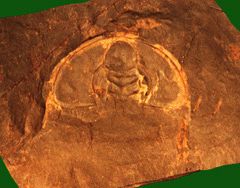 |
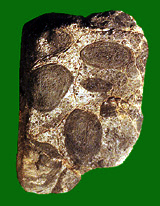 |
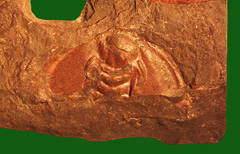 |
|
Click on the images for larger pictures. Here is a series of fossils from the early Cambrian geologic sequence at the famous trilobite quarry in the Marble Mountains. Left to right--(1) a head shield, or cephalon, of a trilobite from the Lower Cambrian Latham Shale--the genus species is Olenellus gilberti; (2) a chunk of limestone from the Lower Cambrian Chambless Limestone bearing dark oval nodules called Girvanella, an extinct genus of blue-green algae precipitated by cyanobacteria; (3) a trilobite head shield from the Lower Cambrian Latham Shale--the genus-species is Mesonacis fremonti. Please note that all specimens were collected on public lands long before the Marble Mountains became part of Mojave Trails National Monument. The Marble Mountains trilobite locality presently lies within Mojave Trails National Monument (officially authorized and established on February 12, 2016), where as of 2017 the BLM (Bureau of Land Management) continues to allow the casual collection of reasonable amounts of common invertebrate fossils--a designation that here includes trilobites; for fossil sites situated on private property, visitors must secure explicit permission from the land owners. |
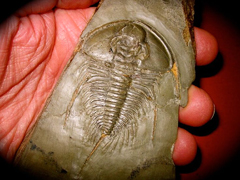 |
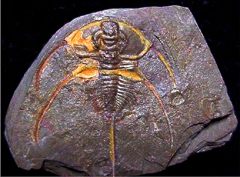 |
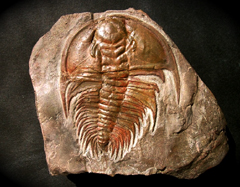 |
|
Click on the images for larger pictures. Here is a series of mostly complete trilobites from the lower Cambrian Latham Shale, California--specimens I did not collect, by the way. The images are courtesy various sources on the Internet. Left and far right--Mesonacis fremonti; middle--Bristolia mohavensis. The Marble Mountains trilobite locality presently lies within Mojave Trails National Monument (officially authorized and established on February 12, 2016), where as of 2017 the BLM (Bureau of Land Management) continues to allow the casual collection of reasonable amounts of common invertebrate fossils--a designation that here includes trilobites; for fossil sites situated on private property, visitors must secure explicit permission from the land owners. |
 |
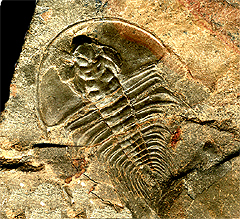 |
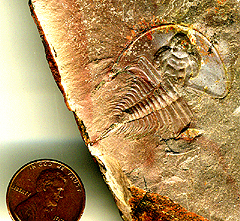 |
|
Click on the images for larger pictures. Here is a series of mostly complete trilobites from the lower Cambrian Latham Shale, California--specimens I did not collect, by the way. The images are courtesy an individual who goes by the cyber-handle Brett Breakin' Rocks. I edited and processed the photographs through photoshop. All three are Mesonacis fremonti. Scale in image at far left is in millimeters. Specimen in middle is a little over an inch long. US penny for scale in photograph at far right; specimen at far right exhibits fascinating taphonomic features; note that the cephalon (head shield) is partially disarticuated from the thorax, the result of post-depostional shifting of the trilobite body. The Marble Mountains trilobite locality presently lies within Mojave Trails National Monument (officially authorized and established on February 12, 2016), where as of 2017 the BLM (Bureau of Land Management) continues to allow the casual collection of reasonable amounts of common invertebrate fossils--a designation that here includes trilobites; for fossil sites situated on private property, visitors must secure explicit permission from the land owners. |
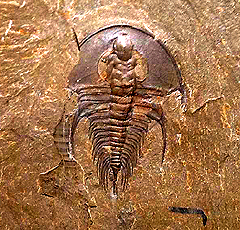 |
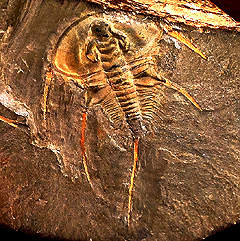 |
 |
|
Click on the images for larger pictures. Here is a series of mostly complete trilobites from the lower Cambrian Latham Shale, California--specimens I did not collect, by the way. Left to right--Olenellus clarki; Bristolia mohavensis (both images courtesy an individual who goes by the cyber-handle PRK; I edited and processed the pictures through photoshop); and Olenellus gilberti (image courtesy an individual who goes by the cyber-handle Trilobite Russ; I edited and processed the picture through photoshop). The Marble Mountains trilobite locality presently lies within Mojave Trails National Monument (officially authorized and established on February 12, 2016), where as of 2017 the BLM (Bureau of Land Management) continues to allow the casual collection of reasonable amounts of common invertebrate fossils--a designation that here includes trilobites; for fossil sites situated on private property, visitors must secure explicit permission from the land owners. |
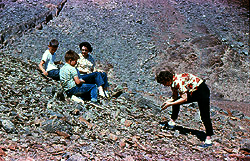 |
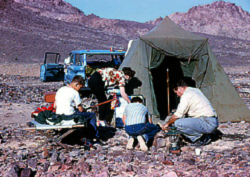 |
|
Click on the images for larger pictures. Left to right--(1) A group of fossil seekers explores with eager attentiveness an exposure of the Lower Cambrian Latham Shale at the classic trilobite quarry in the Marble Mountains; (2) A group of paleontology enthusiasts sets up camp near the famous trilobite quarry in the Marble Mountains. {photographs taken long before the area became part of an established national monument. The Marble Mountains trilobite locality presently lies within Mojave Trails National Monument (officially authorized and established on February 12, 2016), where as of 2017 the BLM (Bureau of Land Management) continues to allow the casual collection of reasonable amounts of common invertebrate fossils--a designation that here includes trilobites; for fossil sites situated on private property, visitors must secure explicit permission from the land owners. |
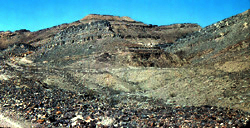 |
 |
|
Click on the images for larger pictures. Left to right--(1) A scenic overview of a portion of the Marble Mountains in the vicinity of the trilobite quarry, revealing the rugged aspect of sedimentary outcropping amidst the early Cambrian sequence of geologic rock formations; (2) A panorama southward from the Marble Mountains, near the trilobite quarry, to a long train sliding across the vast Mojave Desert. Please note that all photographs were taken long before the Marble Mountains became part of the Mojave Trails National Monument. The Marble Mountains trilobite locality presently lies within Mojave Trails National Monument (officially authorized and established on February 12, 2016), where as of 2017 the BLM (Bureau of Land Management) continues to allow the casual collection of reasonable amounts of common invertebrate fossils--a designation that here includes trilobites; for fossil sites situated on private property, visitors must secure explicit permission from the land owners. |
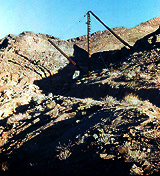 |
 |
|
Click on the images for larger pictures. Left to right--Two views of the famous, long-abandoned Vaughn Quarry in the Marble Mountains, near the classic trilobite quarry. For many years high-grade marble from the early Cambrian times, some 530 million years old, was commercially mined here. These are vintage photos taken by my late father during one of his early experiences in the Marble Mountains. Please note that all photographs were taken long before the Marble Mountains became part of the Mojave Trails National Monument. The Marble Mountains trilobite locality presently lies within Mojave Trails National Monument (officially authorized and established on February 12, 2016), where as of 2017 the BLM (Bureau of Land Management) continues to allow the casual collection of reasonable amounts of common invertebrate fossils--a designation that here includes trilobites; for fossil sites situated on private property, visitors must secure explicit permission from the land owners. |
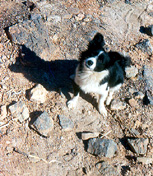 |
 |
|
Click on the images for larger pictures. Left to right--(1) An old friend, the "Desert Hound" himself, Inky, had loads of fun during occasional outings to the Marble Mountains trilobite quarry, Mojave Desert, California; (2) A fossil enthusiast digs into crumbly, poorly exposed early Cambrian sedimentary rocks during a weekend outing in the Marble Mountains trilobite quarry. Please note that all photographs were taken long before the Marble Mountains became part of the Mojave Trails National Monument. The Marble Mountains trilobite locality presently lies within Mojave Trails National Monument (officially authorized and established on February 12, 2016), where as of 2017 the BLM (Bureau of Land Management) continues to allow the casual collection of reasonable amounts of common invertebrate fossils--a designation that here includes trilobites; for fossil sites situated on private property, visitors must secure explicit permission from the land owners. |
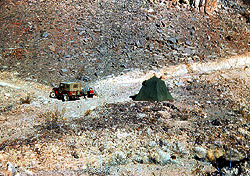 |
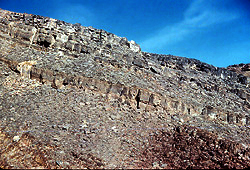 |
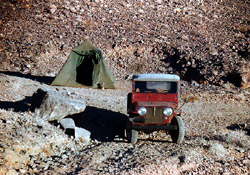 |
|
Click on the images for larger pictures. Left to right--(1) A typical primitive, dry camp near the base of the trail to the classic trilobite quarry in the Marble Mountains; (2) A view to distinctive ledge-forming outcrops of the Lower Cambrian, fossil algae-bearing Chambless Limestone near the famous trilobite quarry in the Marble Mountains; (3) Visits to the Marble Mountains used to involve attempting to negotiate the rock-strewn desert terrain to a convenient camping locality well-downslope from the classic trilobite quarry. Please note that all photographs were taken long before the Marble Mountains became part of the Mojave Trails National Monument. The Marble Mountains trilobite locality presently lies within Mojave Trails National Monument (officially authorized and established on February 12, 2016), where as of 2017 the BLM (Bureau of Land Management) continues to allow the casual collection of reasonable amounts of common invertebrate fossils--a designation that here includes trilobites; for fossil sites situated on private property, visitors must secure explicit permission from the land owners. |
|
This list was compiled from Jack D. Mount's paper, "Characteristic of Early Cambrian Faunas from Eastern San Bernardino County, California," Paleontological Tour of the Mojave Desert, California-Nevada, Southern California Paleontological Society Special Publications, number. 2, 1980.
|
|
This list was compiled from Jack D. Mount's paper, "Characteristic of Early Cambrian Faunas from Eastern San Bernardino County, California," Paleontological Tour of the Mojave Desert, California-Nevada, Southern California Paleontological Society Special Publications, number. 2, 1980.
|
|
This list was compiled from Jack D. Mount's paper, "Characteristic of Early Cambrian Faunas from Eastern San Bernardino County, California," Paleontological Tour of the Mojave Desert, California-Nevada, Southern California Paleontological Society Special Publications, number. 2, 1980.
|
|
|